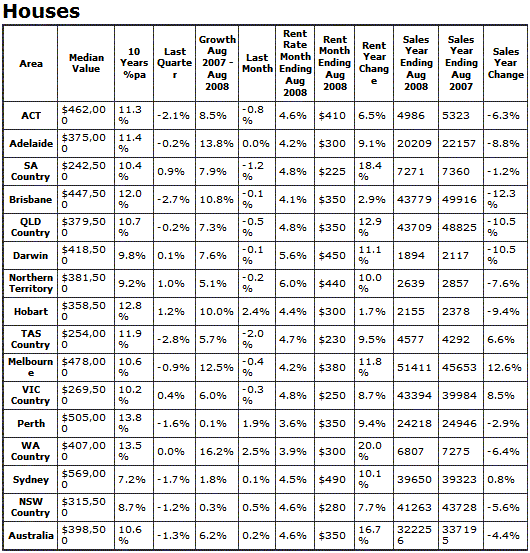No link for some reason this month, email only...
Cheers,
Shadow.
IT’S NOT DOOM AND GLOOM
MARKET WATCH With John Edwards
There’s been a lot of negative attention being given to the current state of the housing market with commentators suggesting property prices might fall to well below those reached before the ’boom’ began nationally. I suppose what you choose to believe depends on what branch of the tree you’re currently sitting on. To me I think these commentators like to throw these tid-bits of fear into the market place because it works for them, it helps to sell their wares and stir up a frenzy.
I’m more pragmatic. Yes I said some time ago that the market might be looking at a once in 100 year event, however since the RBA’s moves to cut interest rates I’m less inclined to think that and believe the RBA has acted to manufacture a soft landing. I don’t think the housing market is going to collapse as it has in the USA, nor do I think you will see prices falling away to the levels these commentators suggest. But don’t call me an optimist, I’m a pragmatist, and the latest Residex statistics in fact show there’s still money to be made in the market.
These figures show that generally, while property sales are down, the values are not falling away significantly. Yes the capital growth might have slowed to the point of zero or a little less, but the market is still relatively stable.
As these stats show, we have seen in the last three months a very significant slow down in the capital growth rates of properties, both houses and units, across the country. For the last two years most capital cities have witnessed capital growth rates jumping leaps and bounds. Adelaide, Brisbane, Darwin and Melbourne and Perth have averaged double digit growth which was simply unsustainable. Similarly, the growth rates of every regional market across the country have also sky-rocketed with an average showing double digits over the last ten years.
The only exception to this double digit growth has been Sydney and regional New South Wales. However, although capital growth rates have generally had much smaller percentage increases, property prices in Sydney as well as the New South Wales regionals are higher than their counterparts in other states which suggest any increase in capital growth expressed as a percentage is generally worth slightly more in dollar figures than the other capital cities and regional areas.
These statistics show this is not anywhere near a collapse in property values, it’s the market positioning itself for a soft landing.

While property sales have fallen away sharply and capital growth stagnated, rental returns are still performing well. The difficulty however lies in finding the better investment opportunities. This is especially the case given the housing affordability problems making it more difficult for investors to purchase additional properties. This is one reason why Residex is releasing its new Best Bargains Report.
WHAT DOES THE CURRENT FINANCIAL SITUATION MEAN FOR MORTGAGES?
Our Aussie banks have been watching nervously as the financial crisis unfolds in the United States. Stocks on the ASX continue to fall and our banks are finally discovering the folly in lending money to people who simply never had the capacity to repay their mortgages long-term. However, while our economy is not immune from international financial market turbulence, Australia's banks are well-capitalised and well-regulated and do not have the same problems as the US faces. Therefore we are not going to see the massive collapse on the scale seen this week by Lehman Brothers and the fire-sale of Merrill Lynch to the Bank of America.
However, unfortunately for the property investor, this turmoil is likely to push up the cost of funding. What this ’credit crunch’ means for you and me is that it will basically cost banks more to lend us money. This is why my opinion on interest rates has changed slightly since my last newsletter. This increased turmoil in the USA is going to put extra pressure on the RBA to continue cutting interest rates. The RBA will want to keep a close eye on the Aussie banks and will act to reduce interest rates if the major banks independently increase their rates. We have already seen the banks independently increase the mortgage rates and the RBA must be concerned they will do it again.
The RBA has released the minutes of its meeting earlier this month, confirming exactly what I said at the time: that it was in no real rush to reduce rates further because the underlying rate of inflation was forecast to rise to 4.5 percent by December. Because those figures are well above the 2-3 percent target band the RBA aims for, they didn’t want to cut interest rates, believing the soft landing in the housing market was likely at the current interest rate levels.
But how quickly times have changed! With the worsening financial situation in the USA and the Aussie market looking on nervously, waiting to see which of the big Aussie banks will feel the flow-on effects, financial markets are now predicting another rate cut by the RBA when its board meets on October 7. I’m convinced another cut in interest rates is likely if the big banks independently increase their rates.
John Edwards,
Cheers,
Shadow.
Last edited:
